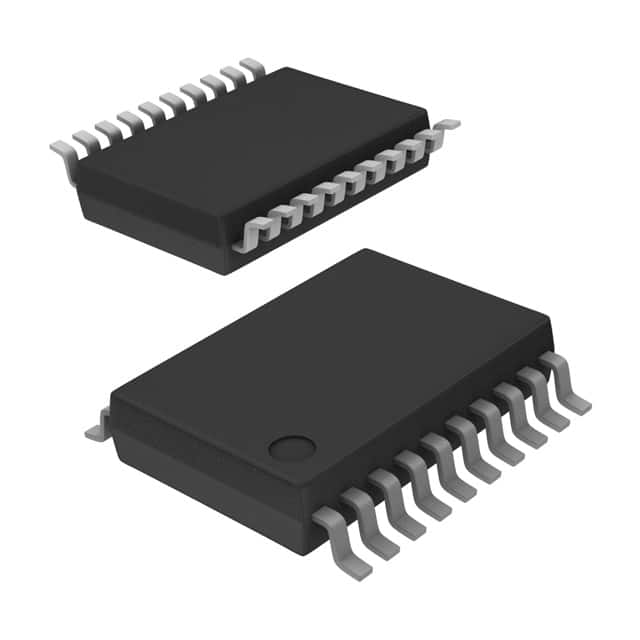ADS1255IDBR
Product Overview
- Category: Integrated Circuit (IC)
- Use: Analog-to-Digital Converter (ADC)
- Characteristics: High-resolution, low-power, serial interface
- Package: 20-pin SSOP (Shrink Small Outline Package)
- Essence: Converts analog signals to digital data
- Packaging/Quantity: Tape and reel, 2500 units per reel
Specifications
- Resolution: 24 bits
- Input Voltage Range: ±Vref
- Sampling Rate: Up to 30,000 samples per second
- Power Supply: 2.7V to 5.25V
- Operating Temperature Range: -40°C to +85°C
Pin Configuration
The ADS1255IDBR has a total of 20 pins, which are assigned as follows:
- AINP: Positive analog input
- AINN: Negative analog input
- AVDD: Analog power supply
- DVDD: Digital power supply
- AGND: Analog ground
- DGND: Digital ground
- CLK: Serial clock input
- DRDY: Data ready output
- CS: Chip select input
- RESET: Reset input
- PWDN: Power-down input
- SCLK: Serial data clock output
- DOUT: Serial data output
- DIN: Serial data input 15-20: NC (No Connection)
Functional Features
- High-resolution ADC with 24-bit resolution
- Low-power consumption for energy-efficient applications
- Serial interface for easy integration with microcontrollers
- Programmable gain amplifier for signal conditioning
- Internal reference voltage for accurate measurements
- Built-in noise filters for improved signal quality
Advantages and Disadvantages
Advantages: - High resolution provides precise measurements - Low-power consumption extends battery life - Serial interface simplifies communication with microcontrollers - Programmable gain amplifier enhances signal conditioning
Disadvantages: - Limited input voltage range may restrict certain applications - Higher cost compared to lower-resolution ADCs - Requires external components for proper operation
Working Principles
The ADS1255IDBR is based on the principle of analog-to-digital conversion. It converts continuous analog signals into discrete digital data using a combination of sampling and quantization techniques. The device samples the analog input voltage at a high rate, then quantizes it into a digital representation with 24-bit resolution. This digital data can be further processed by a microcontroller or other digital devices.
Detailed Application Field Plans
The ADS1255IDBR finds applications in various fields, including:
- Industrial Automation: Precise measurement of sensor outputs in control systems.
- Medical Devices: Accurate acquisition of physiological signals for diagnostic purposes.
- Data Acquisition Systems: Conversion of analog signals to digital data for analysis.
- Instrumentation: High-resolution measurements in scientific and research equipment.
- Energy Monitoring: Monitoring and analyzing energy consumption in smart grid systems.
Alternative Models
Other alternative models that offer similar functionality to the ADS1255IDBR include:
- ADS1248IDBVT: 24-bit ADC with SPI interface and smaller SOT23 package.
- ADS1262IPW: 32-bit ADC with integrated PGA and higher sampling rate.
- MCP3421: 18-bit ADC with I2C interface and lower cost.
These alternative models provide options for different requirements and design constraints.
In conclusion, the ADS1255IDBR is a high-resolution analog-to-digital converter that offers precise measurements, low-power consumption, and a serial interface for easy integration. Its versatile applications make it suitable for various industries, including industrial automation, medical devices, and data acquisition systems. While it has certain limitations, alternative models are available to cater to different needs.
Lista 10 Vanliga frågor och svar relaterade till tillämpningen av ADS1255IDBR i tekniska lösningar
Sure! Here are 10 common questions and answers related to the application of ADS1255IDBR in technical solutions:
Q: What is the ADS1255IDBR? A: The ADS1255IDBR is a high-resolution, low-noise analog-to-digital converter (ADC) designed for precision measurement applications.
Q: What is the resolution of the ADS1255IDBR? A: The ADS1255IDBR has a resolution of up to 24 bits, allowing for highly accurate measurements.
Q: What is the input voltage range of the ADS1255IDBR? A: The ADS1255IDBR has a programmable input voltage range of ±Vref, which can be set by the user.
Q: Can the ADS1255IDBR handle differential inputs? A: Yes, the ADS1255IDBR supports both single-ended and differential inputs, providing flexibility in measuring various signals.
Q: What is the maximum sampling rate of the ADS1255IDBR? A: The ADS1255IDBR can achieve a maximum sampling rate of up to 30,000 samples per second (SPS).
Q: Does the ADS1255IDBR have built-in digital filters? A: Yes, the ADS1255IDBR features an integrated digital filter that can be configured to reduce noise and improve signal quality.
Q: Can the ADS1255IDBR operate with low power consumption? A: Yes, the ADS1255IDBR has a low-power mode that allows it to operate with minimal power consumption, making it suitable for battery-powered applications.
Q: Is the ADS1255IDBR compatible with microcontrollers and other digital systems? A: Yes, the ADS1255IDBR communicates using a serial interface (SPI), making it compatible with a wide range of microcontrollers and digital systems.
Q: Can the ADS1255IDBR be used in industrial environments? A: Yes, the ADS1255IDBR is designed to operate reliably in harsh industrial environments, with features like overvoltage protection and high ESD tolerance.
Q: Are there any evaluation boards or development kits available for the ADS1255IDBR? A: Yes, Texas Instruments provides evaluation boards and development kits that can help users quickly prototype and evaluate the ADS1255IDBR in their applications.
Please note that these answers are general and may vary depending on specific application requirements and implementation details.


